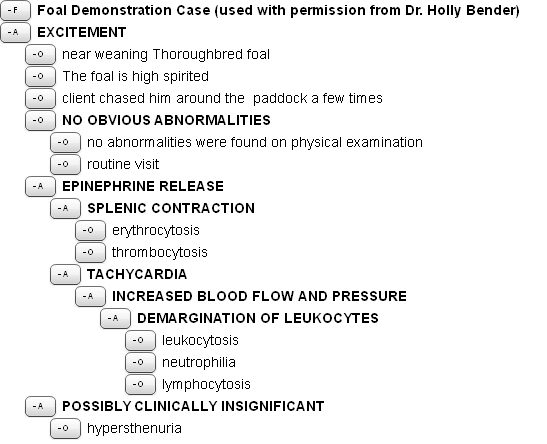The assessment below is based on the following scenario:
Note: The Applied Learning Platform allows authors to use discipline-specific terms for an assessment such as a Diagnostic path, Conceptual approach, etc. You can also explore this assessment in various forms of educational scaffolding by selecting Examples in the Presenter component of the Platform.
You are a practitioner with an interest in equine medicine. During a routine visit to an area stable, your client asks you to perform a physical examination and to draw blood and collect urine from a near weaning Thoroughbred foal for future sale. The potential buyer wants a routine examination before purchasing the animal. The foal is high spirited and makes the client chase him around the paddock a few times before he can be haltered. No abnormalities were found on physical examination.
Discussion:
The entries in bold and denoted with an A (Assertions) are concepts and relationships that have been learned. For example, excitement causes epinephrine release, which causes the spleen to contract and the heart rate to increase (Tachycardia). The tachycardia causes an increase in blood flow and pressure, which causes demargination of leukocytes (white blood cells get washed off of the vessel walls because of the increased flow and turbulence). While these facts could easily be remembered and understood by a veterinary student when taking a multiple choice examination, the real questions are, "How do we know these events are actually occurring in this foal?" "How do we know that learners can apply what they know?"
It is the observations from the scenario that provide the evidence that the assertions in this assessment are not just factually correct in a general sense, but also are situationally correct for this patient. It is these observations that distinguish between excitement and dehydration in this foal. Failure to understand this distinction could result in the foal being subjected to unnecessary treatment with a heightened risk of complication.
Every discipline has a similar set of scenarios for which this type of distinction is critical to a successful outcome, whether it is medical such as this, or a response to an emergency situation in a public place. It is only when scenarios are defined and critical thinking is made explicit that one can know that learners can apply learned facts and concepts. In fact, some educators maintain that unless facts and concepts can be correctly applied, they have not been learned at all.
